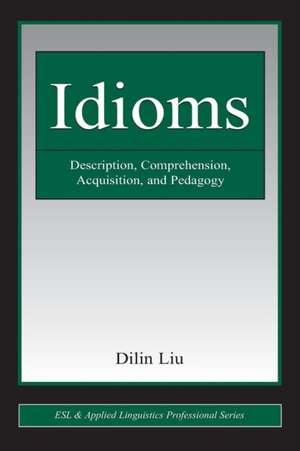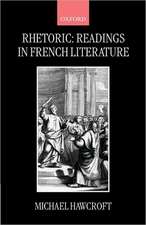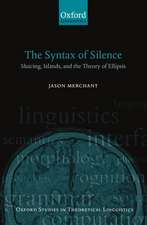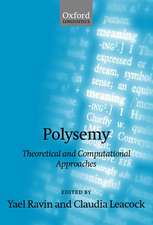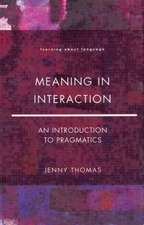Idioms: Description, Comprehension, Acquisition, and Pedagogy: ESL & Applied Linguistics Professional Series
Autor Dilin Liuen Limba Engleză Paperback – 10 dec 2007
- Part I includes discussion of idiom definition, classification, usage patterns, and functions.
- Part II investigates the process involved in the comprehension of idioms and the factors that influence individuals’ understanding and use of idioms in both L1 and L2.
- Part III explores idiom acquisition and the teaching and learning of idioms, focusing especially on the strategies and techniques used to help students learn idioms.
Idioms is designed to serve either as a textbook for ESL/applied linguistics teacher education courses or as a reference book. No matter how the book is used, it will equip ESL/applied linguistics students and professionals with a solid understanding of various issues related to idioms and the learning of them.
| Toate formatele și edițiile | Preț | Express |
|---|---|---|
| Paperback (1) | 476.64 lei 43-57 zile | |
| Taylor & Francis – 10 dec 2007 | 476.64 lei 43-57 zile | |
| Hardback (1) | 1108.37 lei 43-57 zile | |
| Taylor & Francis – 10 dec 2007 | 1108.37 lei 43-57 zile |
Din seria ESL & Applied Linguistics Professional Series
-
 Preț: 324.49 lei
Preț: 324.49 lei -
 Preț: 311.18 lei
Preț: 311.18 lei -
 Preț: 304.48 lei
Preț: 304.48 lei -
 Preț: 362.49 lei
Preț: 362.49 lei -
 Preț: 310.85 lei
Preț: 310.85 lei -
 Preț: 363.93 lei
Preț: 363.93 lei -
 Preț: 310.22 lei
Preț: 310.22 lei -
 Preț: 303.79 lei
Preț: 303.79 lei -
 Preț: 312.86 lei
Preț: 312.86 lei -
 Preț: 311.28 lei
Preț: 311.28 lei -
 Preț: 274.23 lei
Preț: 274.23 lei -
 Preț: 310.85 lei
Preț: 310.85 lei -
 Preț: 310.45 lei
Preț: 310.45 lei -
 Preț: 310.99 lei
Preț: 310.99 lei - 9%
 Preț: 905.23 lei
Preț: 905.23 lei -
 Preț: 402.10 lei
Preț: 402.10 lei -
 Preț: 326.45 lei
Preț: 326.45 lei -
 Preț: 325.89 lei
Preț: 325.89 lei -
 Preț: 309.70 lei
Preț: 309.70 lei -
 Preț: 311.37 lei
Preț: 311.37 lei -
 Preț: 363.46 lei
Preț: 363.46 lei -
 Preț: 397.88 lei
Preț: 397.88 lei -
 Preț: 484.77 lei
Preț: 484.77 lei -
 Preț: 450.03 lei
Preț: 450.03 lei - 15%
 Preț: 444.71 lei
Preț: 444.71 lei -
 Preț: 452.53 lei
Preț: 452.53 lei - 18%
 Preț: 1054.97 lei
Preț: 1054.97 lei - 30%
 Preț: 320.53 lei
Preț: 320.53 lei - 25%
 Preț: 125.07 lei
Preț: 125.07 lei -
 Preț: 487.10 lei
Preț: 487.10 lei -
 Preț: 304.90 lei
Preț: 304.90 lei -
 Preț: 473.15 lei
Preț: 473.15 lei - 18%
 Preț: 1002.63 lei
Preț: 1002.63 lei - 26%
 Preț: 873.52 lei
Preț: 873.52 lei - 18%
 Preț: 1054.58 lei
Preț: 1054.58 lei - 18%
 Preț: 1056.28 lei
Preț: 1056.28 lei -
 Preț: 479.47 lei
Preț: 479.47 lei - 18%
 Preț: 1284.97 lei
Preț: 1284.97 lei - 15%
 Preț: 443.08 lei
Preț: 443.08 lei - 18%
 Preț: 1113.12 lei
Preț: 1113.12 lei - 18%
 Preț: 1219.68 lei
Preț: 1219.68 lei - 25%
 Preț: 768.10 lei
Preț: 768.10 lei
Preț: 476.64 lei
Nou
Puncte Express: 715
Preț estimativ în valută:
91.21€ • 95.47$ • 75.91£
91.21€ • 95.47$ • 75.91£
Carte tipărită la comandă
Livrare economică 31 martie-14 aprilie
Preluare comenzi: 021 569.72.76
Specificații
ISBN-13: 9780805863468
ISBN-10: 080586346X
Pagini: 224
Ilustrații: 6 tables and Style copy Researching Second Language Classrooms
Dimensiuni: 152 x 229 x 15 mm
Greutate: 0.32 kg
Ediția:1
Editura: Taylor & Francis
Colecția Routledge
Seria ESL & Applied Linguistics Professional Series
Locul publicării:Oxford, United Kingdom
ISBN-10: 080586346X
Pagini: 224
Ilustrații: 6 tables and Style copy Researching Second Language Classrooms
Dimensiuni: 152 x 229 x 15 mm
Greutate: 0.32 kg
Ediția:1
Editura: Taylor & Francis
Colecția Routledge
Seria ESL & Applied Linguistics Professional Series
Locul publicării:Oxford, United Kingdom
Cuprins
@contents: Selected Contents:
Table of Contents
Preface
Part I: Idiom Description: Definition and Use:
Chapter 1. . . Idiom Definition and Classification
Introduction
Defining idioms: Diverse views
A perspective from language learners
Classification of idioms
Phrasal verbs: A unique group of idioms
Summary
Chapter 2. . . Idiom Use: Function, Variation, Frequency, Register
Introduction
The idiom principle
Function
Variation
Register
Culture and idiom use
Summary
Part II: Idiom Comprehension
Chapter 3. . . L1 Idiom Comprehension
Introduction
Five major processing models
The disassociation of semantic and syntactic processing
The idiom key hypothesis
Summary
Chapter 4. . . L2 Idiom Comprehension
Introduction
Major strategies used
Unique Processing model
Summary
Chapter 5. . . Factors that Affect Idiom Comprehension
Introduction
Factors on the part of idioms and their use
Factors on the part of language users
Factors affecting L2 idiom comprehension only
Summary
Part III: Idiom Acquisition and Pedagogy
Chapter 6. . . Idiom Acquisition and Its importance in language development
Introduction
Skills and knowledge needed for idiom acquisition
The role of rote learning
The effect of different types of idioms and sequence of idiom acquisition
The importance of idioms in language development
Summary
Chapter 7. . . Selection and Organization of Idioms for instruction
Introduction
Selection criteria and useful selection practices
Types of information needed
Idiom organization
Passive vs. active idioms
Summary
Chapter 8. . . Idiom Pedagogy: Macro strategies and General approaches
Introduction
Raising students’ sensitivity to and interest in idioms
Incorporating idiom teaching into the entire curriculum
Advancing a heuristic approach with discovery learning activities and
adequate contextual information
Promoting "conceptual motivation analysis" and L2 cultural knowledge
Employing a variety of activities to deal with different types of idioms and
accommodate diverse learners
Using direct study as a supplement to contextualized learning
Enhancing idiom retention with effective mnemonic strategies
Training and boosting learning strategy use
Conducting unplanned idiom teaching
Overcoming avoidance error and welcoming creative idiom use
Pros and cons of proactive vs. retroactive approach
Summary
Chapter 9. . . Idiom Pedagogy: Micro strategies and Techniques
Introduction
Noticing and identifying idioms
Understanding idioms and developing interpretation strategies
Analyzing idioms for connotation, register and other in-depth understanding
Retrieving and using idioms for comprehension
Retrieving, generating, and using idioms for production
Using effective mnemonic techniques for retention
Explaining idioms to help students notice and understand them
Using idiom dictionaries
Summary
Chapter 10. . .Error treatment and assessment in idiom instruction
Errors and their treatment
Assessment
Summary
Table of Contents
Preface
Part I: Idiom Description: Definition and Use:
Chapter 1. . . Idiom Definition and Classification
Introduction
Defining idioms: Diverse views
A perspective from language learners
Classification of idioms
Phrasal verbs: A unique group of idioms
Summary
Chapter 2. . . Idiom Use: Function, Variation, Frequency, Register
Introduction
The idiom principle
Function
Variation
Register
Culture and idiom use
Summary
Part II: Idiom Comprehension
Chapter 3. . . L1 Idiom Comprehension
Introduction
Five major processing models
The disassociation of semantic and syntactic processing
The idiom key hypothesis
Summary
Chapter 4. . . L2 Idiom Comprehension
Introduction
Major strategies used
Unique Processing model
Summary
Chapter 5. . . Factors that Affect Idiom Comprehension
Introduction
Factors on the part of idioms and their use
Factors on the part of language users
Factors affecting L2 idiom comprehension only
Summary
Part III: Idiom Acquisition and Pedagogy
Chapter 6. . . Idiom Acquisition and Its importance in language development
Introduction
Skills and knowledge needed for idiom acquisition
The role of rote learning
The effect of different types of idioms and sequence of idiom acquisition
The importance of idioms in language development
Summary
Chapter 7. . . Selection and Organization of Idioms for instruction
Introduction
Selection criteria and useful selection practices
Types of information needed
Idiom organization
Passive vs. active idioms
Summary
Chapter 8. . . Idiom Pedagogy: Macro strategies and General approaches
Introduction
Raising students’ sensitivity to and interest in idioms
Incorporating idiom teaching into the entire curriculum
Advancing a heuristic approach with discovery learning activities and
adequate contextual information
Promoting "conceptual motivation analysis" and L2 cultural knowledge
Employing a variety of activities to deal with different types of idioms and
accommodate diverse learners
Using direct study as a supplement to contextualized learning
Enhancing idiom retention with effective mnemonic strategies
Training and boosting learning strategy use
Conducting unplanned idiom teaching
Overcoming avoidance error and welcoming creative idiom use
Pros and cons of proactive vs. retroactive approach
Summary
Chapter 9. . . Idiom Pedagogy: Micro strategies and Techniques
Introduction
Noticing and identifying idioms
Understanding idioms and developing interpretation strategies
Analyzing idioms for connotation, register and other in-depth understanding
Retrieving and using idioms for comprehension
Retrieving, generating, and using idioms for production
Using effective mnemonic techniques for retention
Explaining idioms to help students notice and understand them
Using idiom dictionaries
Summary
Chapter 10. . .Error treatment and assessment in idiom instruction
Errors and their treatment
Assessment
Summary
Recenzii
"Overall, the book is an excellent reference for pre- and in-service language teachers, as well as those interested in the basics of idioms and language teaching. The accessible language, the quick summary and discussion questions that follow each chapter, the glossary, and the annotated list of selective idiom references make this book especially attractive for graduate courses in applied linguistics and related fields."--Teachers College Record
"The book draws on a lot of research, is friendly to the reader, and will be of good value to teachers." --Paul Nation, Victoria University of Wellington, Australia
"The book draws on a lot of research, is friendly to the reader, and will be of good value to teachers." --Paul Nation, Victoria University of Wellington, Australia
Descriere
This comprehensive, up-to-date, and accessible text on idiom use, learning, and teaching approaches the topic with a balance of sound theory and extensive research in cognitive linguistics, psycholinguistics, corpus linguistics, and sociolinguistics combined with informed teaching practices.
Idioms is designed to serve either as a textbook for ESL/applied linguistics teacher education courses or as a reference book. No matter how the book is used, it will equip ESL/applied linguistics students and professionals with a solid understanding of various issues related to idioms and the learning of them.
Idioms is designed to serve either as a textbook for ESL/applied linguistics teacher education courses or as a reference book. No matter how the book is used, it will equip ESL/applied linguistics students and professionals with a solid understanding of various issues related to idioms and the learning of them.
